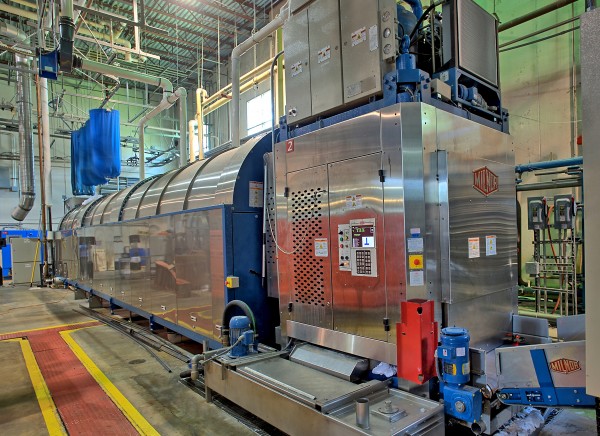Since the 1960’s, laundries have been making the switch from washer extractors to tunnel washers to accommodate their growing businesses and needs. If your laundry has seen increased production or expects to increase regular volumes, you may be looking for new equipment to handle the extra demands. Many laundries chose to switch from washer extractors to tunnels to be more efficient and productive.
Although Tunnel washers are costly to purchase, there is no doubt that if your laundry is processing more than 4 tonnes per day, you should be considering a Tunnel washer. Not only is it more productive, but the productivity and resource efficiencies will claw back that initial capital outlay very quickly.

There are several factors to consider when selecting the right product for your needs. Centralised laundries seek out the least expensive combination of equipment & operating costs (water, waste, chemicals & labour) over the life of the equipment. The initial solution for small quantities of linen is a washer-extractor & manual dryer. We would normally recommend a tunnel when your production grows over 500 kg per hour, automating your facility & minimising inputs becomes a necessity at this point.
There are many factors to help determine if purchasing a Tunnel Washer is the right solution for your laundry.
In 1979, Milnor tunnels introduced the True Top Transfer feature, which leaves the excess dirty water behind in each module. The batch washer lifts the linen load completely out of the wash bath via a perforated scoop & transfer it over the top of a fixed, welded-in-place bulkhead into the next module. The baths in each module are be completely separated, with no wearable seals nor perforated bulkheads in between.
The wash and rinse water is allowed to counterflow through all such modules against the flow of linen to properly carry all the dirty & unused chemicals back towards the soil (loading) part of the machine.
Our internal cylinders volumes have a volumetric loading of more than 40 litres per kilogram, sufficient to prevent the linen from packing too tightly and thus allow good mechanical action & proper dispersion of wash fluids.
Milnor's True Top Transfer design allows for faster washing, approximately 30 to 40% faster than bottom transfer designs, with better rinsing & superior wash quality, as chemicals are better targeted to proper baths.
Since 2009, Milnor has enhanced the True Top Transfer tunnel concept with PulseFlow technology, which incorporates standing bath washing with controlled intermittent high velocity counterflow in every process module. Our inverter controlled pumps, electronic flow meter & external weirs offer more efficient washing & rinsing.
PulseFlow technology begins with the patented RecircONE pump arrangement feature, producing high-speed water recirculation with the first module at a rate of approximately 400 litres per minute. This process allows for fast & nearly instant wet-downm causing the water & wash chemistry to instantly penetrate the soiled linen. This saves time & the need for dedicated wet down modules, which are utilised in bottom transfer tunnels.
The PulseFlow wash process then continues with a three-step wash / dilution process in each module:
Milnor’s PulseFlow technology has been awarded a Hohenstein Hygienically Clean “Certificate of Innovation”, for achieving as low as 2.5 L/KG fresh water consumption for light to medium soil linen & as low as 5.4 L/KG for heavy soil (examples food & beverage).
Mentor control allows pre-determined temperature and chemical levels for each individual bath.
Control - The operator puts a batch in line for loading, then enters the goods classification number into the Mentor® Control. This automatically selects the processing formula which follows the batch until it’s automatically unloaded from the dryer and delivered to its finishing destination.
Any module can be equipped with a steam inlet and temperature probe.
A conveyor or overhead bag system may feed the load chute.
Each module has a stationary shell to hold the wash bath and a rotating, perforated inner cylinder. Each module can be used for different baths. Goods proceed through the formula by traveling from module to module, via a perforated top transfer scoop. There are no stops and starts for draining and filling after each bath. This saves time, compared to conventional washing machinery.
Supply inlets can be placed in each module. The Mentor control dictates the amount of supplies and when, or if, they are added to the specific goods in each module during the wash cycle.
Post Wash - The MultiTrac system relays each batch’s post-wash requirements to other parts of the system; extractor, shuttle, dryers and conveyors. A CRT display identifies batch location and status. Where multiple batch dryers are used, the control system prevents mixing of incompatible batches in the same dryer
There are many features designed into a Milnor tunnel to reduce the total cost of ownership – saving you money for years AFTER your initial investment: